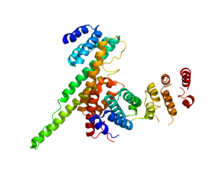Nucleoporin
| Nucleoporin 133/155, N terminal | |||||||||
|---|---|---|---|---|---|---|---|---|---|
| |||||||||
| Nucleoporin 133/155, C terminal (ACE2) | |||||||||||
|---|---|---|---|---|---|---|---|---|---|---|---|
 NUP133 (this domain; right) interacting with NUP107 (PDB 3CQC). | |||||||||||
| Identifiers | |||||||||||
| Symbol | Nucleoporin_C | ||||||||||
| Pfam | PF03177 | ||||||||||
| InterPro | IPR007187 | ||||||||||
| |||||||||||
| FG repeat | |||||||||
|---|---|---|---|---|---|---|---|---|---|
| Identifiers | |||||||||
| Symbol | Nucleoporin_FG | ||||||||
| Pfam | PF13634 | ||||||||
| Pfam clan | CL0647 | ||||||||
| InterPro | IPR025574 | ||||||||
| |||||||||
Nucleoporins are a family of proteins which are the constituent building blocks of the
Structure
Nucleoporins aggregate to form a
In a scaffold subcomplex, both the cytoplasm and the nucleoplasm rings are made up of Y-complexes, a protein complex built out of, among others, NUP133 and NUP107. On each end of each of the eight scaffolds are two Y-complexes, adding up to 32 complexes per pore.[4] The relationship of the membrane curvature of a nuclear pore with Y-complexes can be seen as analogous to the budding formation of a COPII coated vesicle.[3] The proteins lining the inner pore make up the NUP62 complex.[4]
On the nucleoplasm side, extra proteins associated with the ring form "the nuclear basket", a complex capable of tethering the nucleoporin to the nuclear lamina and even to specific parts of the genome.[4] The cytoplasmic end is less elaborate, with eight filaments projecting into the cytoplasm. They don't seem to have a role in nuclear import.[5]
Some nucleoporins contain FG repeats. Named after
Membrane nucleoporins associate with both the scaffold and the nuclear membrane. Some of them, like
Nucleoporins have been shown to form various subcomplexes with one another. The most common of these complexes is the nup62 complex, which is an assembly composed of
Evolution
Many structural nucleoporins contain solenoid protein domains, domains consisting of repeats that can be stacked together as bulk building blocks. There are beta-propeller domain with similarities to WD40 repeats, and more interestingly, unique types of alpha solenoid (bundles of helixes) repeats that form a class of their own, the ancestral coatomer elements (ACE). To date, two classes of ACEs have been identified. ACE1 is a 28-helix domain found in many scaffolding nucleoproteins as well as SEC31, a component of COPII. ACE2, shown in the infobox, is found in yeast Nup157/Nup170 (human Nup155) and Nup133. In either case, the shared domains, like their names suggest, indicate a shared ancestry both within nucleoproteins and between nucleoproteins and cotamers.[9]
All living eukaryotes share many important components of the NPC, indicating that a complete complex is present in their common ancestor.[10]
Function
Nucleoporins mediate transport of
Transport mechanism
Nucleoporins regulate the transport of macromolecules through the
Pathology
Several diseases have been linked to pathologies of nucleoporins, notably
Nucleoporins have been shown to be highly sensitive to
Decreases in the production of the p62 complex are common to many
Increased expression of the
Nucleoporin protein aladin is a component of the nuclear pore complex. Mutations in the aladin gene are responsible for triple-A syndrome, an autosomal recessive neuroendocrinological disease. Mutant aladin causes selective failure of nuclear protein import and hypersensitivity to oxidative stress.[19] The import of DNA repair proteins aprataxin and DNA ligase I is selectively decreased, and this may increase the vulnerability of the cell's DNA to oxidative stress induced damages that trigger cell death.[19]
Examples
Each individual nucleoporin is named according to its molecular weight (in kilodaltons). Below are several examples of proteins in the nucleoporin family:
- NUP50
- NUP93, NUP98
- NUP188
- NUP214
References
- PMID 9159086.
- ^ PMID 10926833.
- ^ ISBN 978-1-4292-3413-9.
- ^ S2CID 35394962. Retrieved 10 April 2019.
- PMID 12105182.
- PMID 12604785.
- ^ PMID 12753810.
- PMID 15146057.
- PMID 19674973.
- PMID 20949036.
- PMID 12543930.
- PMID 16739728.
- PMID 20977914.
- PMID 26541386.
- PMID 24066078.
- PMID 8923203.
- PMID 19481605.
- ^ "Entrez Gene: NUP88 nucleoporin 88kDa"
- ^ PMID 16467144.
External links
- Nucleoporin at the U.S. National Library of Medicine Medical Subject Headings (MeSH)
- Nucleoporin (InterPro search)
